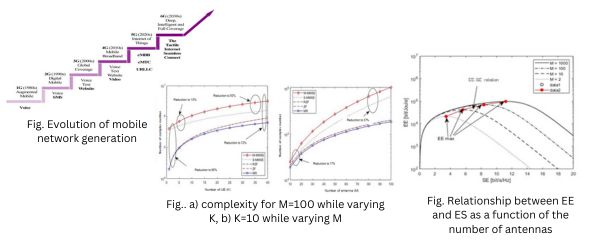PERFORMANCE EVALUATION OF A MASSIVE MIMO M-MMSE SYSTEM IN TERMS OF ENERGY EFFICIENCY BASED ON THE POWER CIRCUIT CONSUMPTION MODEL (PC)
DOI:
https://doi.org/10.26662/ijiert.v11i2.pp33-43Keywords:
CP, Energy Efficiency, Massive MIMO, M-MMSE, ThroughputAbstract
The implementation of massive MIMO technology presents a significant boost in throughput mobile networks. However, this technological advancement comes increases energy consumption. The amalgamation of Massive MIMO with M-MMSE serves as a strategic solution, effectively mitigating energy consumption while delivering substantial throughput and improved Energy Efficiency (EE) compared to alternative techniques. Our study delves into the Energy Efficiency of massive MIMO using the Power Circuit Consumption (PC) model, providing valuable insights into its performance. This analytical approach not only enables a reduction in energy usage but also facilitates a noteworthy enhancement in Spectral efficiency (SE) and EE concurrently. This concurrent improvement addresses the challenge posed by the initial surge in energy consumption associated with massive MIMO deployment, ensuring a sustainable and efficient integration into mobile networks.

Downloads
Published
Issue
Section
License

This work is licensed under a Creative Commons Attribution-NonCommercial-NoDerivatives 4.0 International License.
Under the Creative Commons Attribution-NonCommercial-NoDerivatives 4.0 International License (CC BY-NC-ND 4.0 DEED).
You are free to:
- Share — copy and redistribute the material in any medium or format
- The licensor cannot revoke these freedoms as long as you follow the license terms.
Under the following terms:
- Attribution — You must give appropriate credit , provide a link to the license, and indicate if changes were made . You may do so in any reasonable manner, but not in any way that suggests the licensor endorses you or your use.
- NonCommercial — You may not use the material for commercial purposes .
- NoDerivatives — If you remix, transform, or build upon the material, you may not distribute the modified material.
- No additional restrictions — You may not apply legal terms or technological measures that legally restrict others from doing anything the license permits.
Notices:
You do not have to comply with the license for elements of the material in the public domain or where your use is permitted by an applicable exception or limitation .
No warranties are given. The license may not give you all of the permissions necessary for your intended use. For example, other rights such as publicity, privacy, or moral rights may limit how you use the material.
Rights of Authors
Authors retain the following rights:
1. Copyright and other proprietary rights relating to the article, such as patent rights,
2. the right to use the substance of the article in future works, including lectures and books,
3. the right to reproduce the article for own purposes, provided the copies are not offered for sale,
4. the right to self-archive the article.

